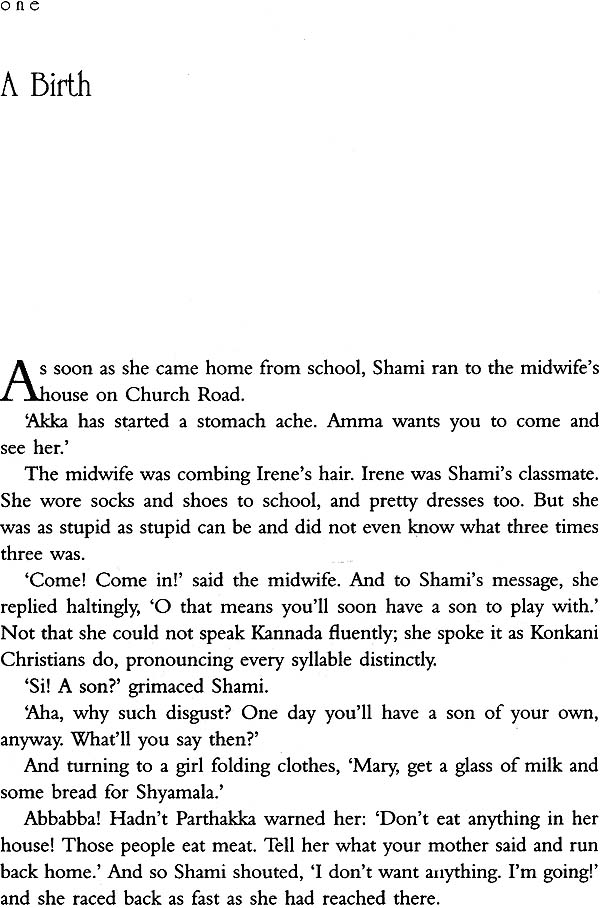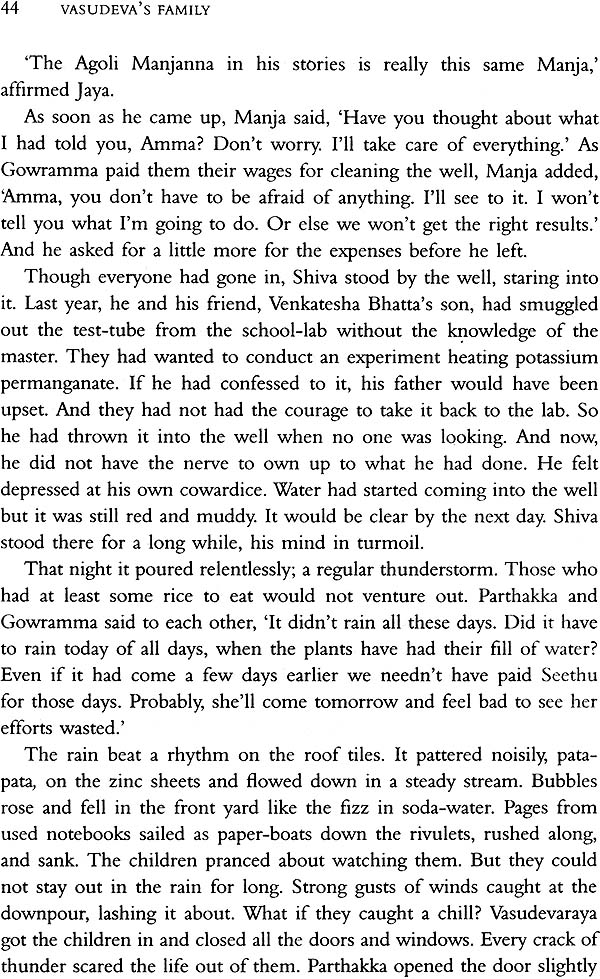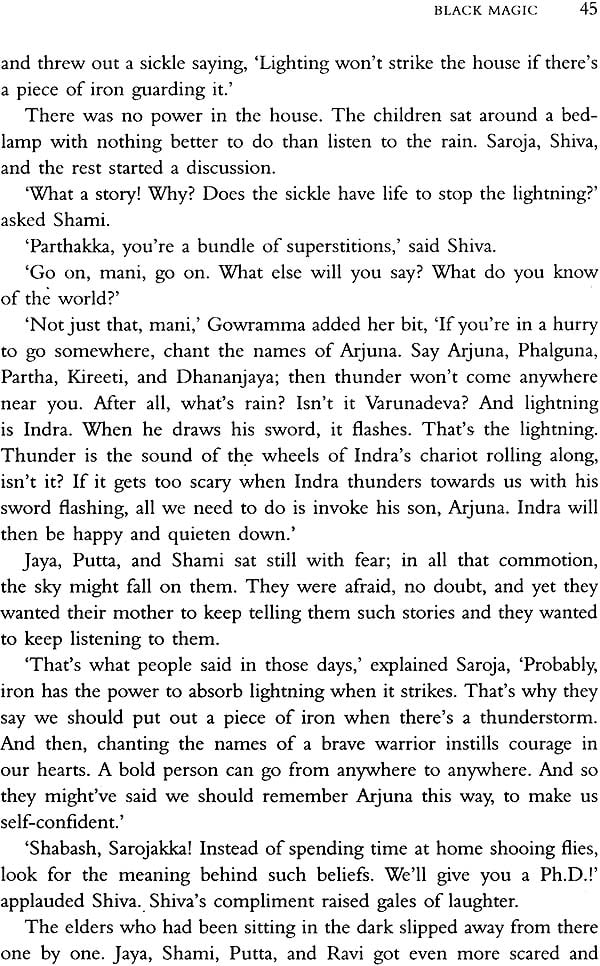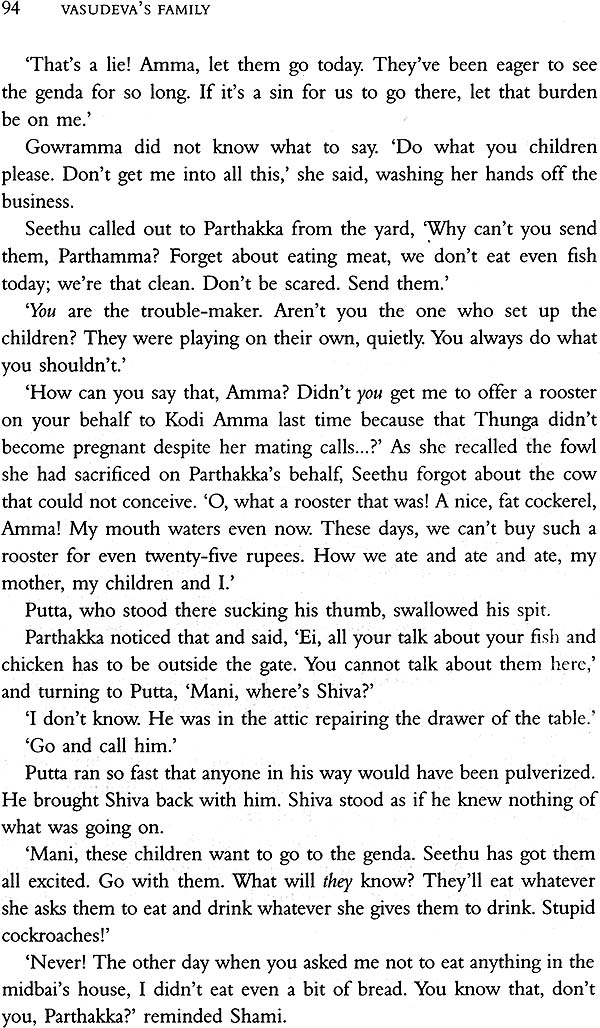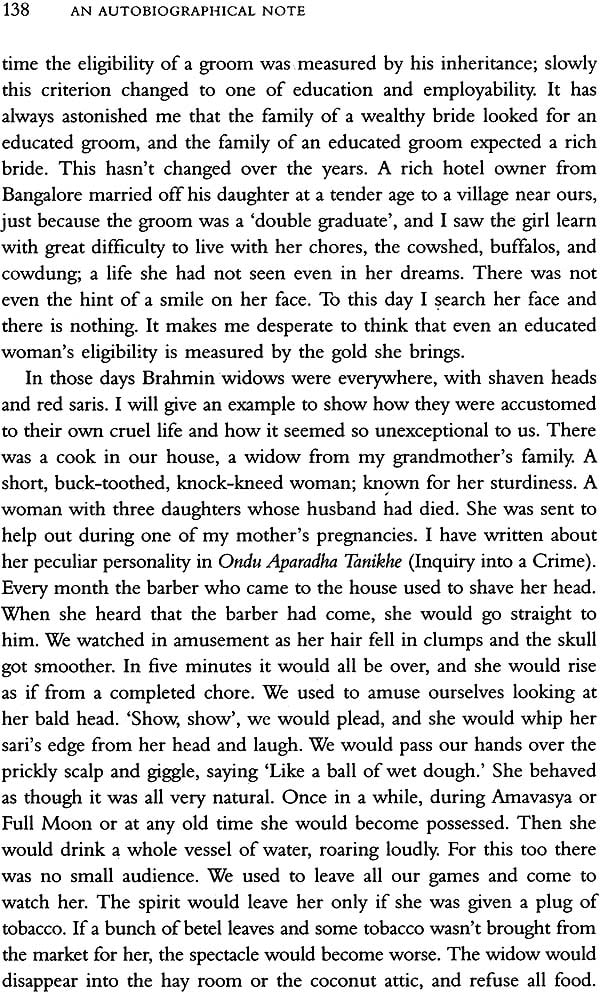
Vasudeva's Family (Asprushyaru)
Book Specification
| Item Code: | NAG383 |
| Author: | Vaidehi |
| Publisher: | Oxford University Press, New Delhi |
| Language: | English |
| Edition: | 2012 |
| ISBN: | 9780198089612 |
| Pages: | 182 |
| Cover: | Hardcover |
| Other Details | 9.0 inch X 6.0 inch |
| Weight | 350 gm |
Book Description
Written three decades ago, this novel unfolds delicately to offer a serious and subtle study of the practice of untouchability. The book is about the politics of purity and pollution that works together with the politics of compassion, each bouncing off the other.
To break such a system, the daughter of a Brahmin should be prepared to wash the glass from which the low-caste officer has drunk coffee with her father. The transformation is not easy in Vasudevaraya's household; nevertheless, it rears a new generation of children who think for themselves and question traditional beliefs and practices. Vaidehi is one of the few writers in Kannada who could, as far back as 1982, sense that the influence of the caste system was fading.
This translation captures the nuances and moods of the multilayered narrative and symbolic language of the original. With a comprehensive Introduction and an Autobiographical Note, this work will appeal to students and teachers of Indian writing, comparative literature, and translation, cultural, and gender studies.
Vaidehi, the most famous woman writer in Kannada, is the recipient of the Kamataka State Sahirya Akademi award as well as the prestigious Daana Chintamani Attimabbe State award, Katha Prize, and Kendra Sahitya Akademi award. Her work, Temple Fair, is part of the critically acclaimed Five Novellas by Women Writers (OUP 2008).
I am a home-grown writer; my Kannadiga world-view was formed by the elders of my family. It began in the inner rooms of our house, a home filled with adults and children of almost every size and variety; from their responses to the joys and sorrows that came our way. In a house with babies, a lullaby like this one was a constant drone:
Why are you crying, my sweet little one?
You have everything you need.
When you ask, I'll give you frothy milk from four buffiloes.
Frothy milk from four buffaloes sweetened with sugar.
And also pseudo curses like:
May the who scolded my little babu burn without food! May they waste away like red mud in water!
Through whatever was said or sung by whoever was at home or whoever was visiting, the language of the inner rooms entered my ears and spread out within me, without me being quite aware of what it meant. Isn't it primarily through the language of our inner rooms that we are initiated to a language and a culture that shapes our mind-set even when we do not yet know the name of that language? At the base of a language is the mother. Our minds are formed on her lap through her songs, her nurturing care, her stories. I must also mention a word from the world of women, from streeloka, a word I used to hear from my mother, hadha, balance. Bringing about a balance. This balance was not something which could be measured, not something clearly defined. Each person had to find the appropriate balance. This concept of balance we have in India is to be found more in our kitchens and the inner life of our homes than in the lives of sages. My desire is to achieve in my writing, the balance I have heard about in the inner world of the home.
My mother used to sing a long song while patting babies to sleep. It was the story of Anasuya, and the Divine Trinity, Brahma, Vishnu, and Maheshwara. The Trinity come as suggested by their wives to test the chastity of Anasuya, the ascetic wife of sage Athri. They ask her to feed them without wearing any clothes. She is not unnerved by the divine request. Through the power of her penance, Anasuya transforms them into babies and nurses them in the nude. From one of the inner rooms, Mother's lullaby would softly waft out in waves to our ears while we were playing, studying, .... We used to enter the story by cheering the quick-witted Anasuya who could change the Trinity into babies and teach Saraswathi, Lakshmi, and Parvathi a lesson in humility.
And now? The same story from the Puranas I has become the universal theme of any woman's ability to deftly overcome any predicament with her sense of self-worth. The way Anasuya passed the test with her dignity intact has come down to us in songs and stories through our language; first by word of mouth, moukhika, and later, in books. Many such stories have shaped our mind-set long before we were aware of our identity as Indians. This is how the world-view of a people is nurtured, from budding on the mother's lap to blossoming in the world outside. This is why we see language as mother. Language becomes the goddess of the people; literature becomes their wealth, their Bhuvaneshwari, the Goddess of the Earth. And this Bhuvaneshwari becomes a blessing to the world.
In this translation of Asprushyaru into English as Vasudeoa's Family, I see my novel moving out of the inner rooms to the world beyond, transcending language and cultural barriers.
Susheela and I spent three days reading the novel together and enjoying the flow of the story from one language to the other. While reading her version, I felt I was reading the story in Kannada. I thank Mini Krishnan for getting Asprushyaru translated into English by Susheela Punitha and for the zeal with which she led us through the process as if it were a mission. I thank Tejaswini Niranjana for her translation of my 'writer's pages' that provides the context for my writing and K.S. Vaishali for the detailed introduction that gives an idea of Modern Kannada Literature.
Kannada Literary Heritage and Marginalized Voices
With a seamless and an unbroken literary history of fifteen hundred W years, Kannada language and literature occupy a pre-eminent position among the literatures of the Indian sub-continent. The earliest example of a full-length Kannada language stone inscription containing Brahmi characters with graphological characteristics attributed to those of proto-Kannada in Old Kannada script can be found in the Halmidi stone inscription dated about AD 450.
Kannada literary history dates back to the reign of the kings of the Rashtrakuta dynasty and the emergence of the first seminal work in Kannada literary criticism entitled Kavirajamarga during the reign of King Nrupatunga of this dynasty in ninth century AD is hailed as an epoch making event in the annals of Kannada literary heritage.
Nevertheless, this literary history essentially has had a male supremacist orientation. Therefore, it is no small wonder that the marginalized voices in the pages of Kannada literature have been those of women. Women writers are unheard of in the corridors of the Kannada literary establishment. Though tracing the literary subculture of women writers and their writings from the annals of early Kannada literary history is indeed a daunting task, its importance can hardly be over-emphasized. Female literary creativity has always had to contend precariously with too many patriarchal surveillance mechanisms that thwart its expression. In the ancient pages of Kannada literature, Kanthi has the distinction of being the first woman poet. Eulogized and lauded as Abhinava Vagdevi' a veritable incarnation of the Goddess of learning, Kanthi is known to have been a contemporary of the poet Nagachandra of the eleventh century AD. Given the almost quasi-mythical status of Kanthi owing to insufficient historical evidence, the incipient female voices of creative articulation are those of the Kannada vachanakarthis in the context of twelfth century Kalyana and the nubhava Mantapa', a philosophical forum established by Basavanna, the great social reformer renowned for his revolutionary zeal. Alongside the famous vachanakaras and principal saints of the Veerashiva movement in Karnataka like Allama Prabhu and Basavanna, there are the vachanakarthis like Akka Mahadevi, Aydakki Lakkamma, the wife of Aydakki Marayya, Kadira Remmavve, Sule Sankavva, Kalavve, the wife ofUrilingapeddi who was a prominent vachanakara from the lower caste of Shudras, Dhoopada Goggavve, Basavanna's wife Neelambike, and others who have written tremendously insightful and unforgettable vachanas.
Sanchiya Honnamma (Sventeenth Century) and Thereafter Afier the twelfth century vachanakarthis, there seems to be a long hiatus and an interregnum of over four centuries after which we hear of Sanchiya Honnamma in the seventeenth century. She was known as 'Sarasasahityada Varadevate' which literally meant the 'Goddess of exquisite poetry' (a title bestowed upon her by her mentor, the court poet Singaracharya). Honnamma, a talented poet and a conventional thinker who upheld the virtues of a 'pativrata shiromani' (a wife devoted to her husband was considered to be the ideal of womanhood) wrote 'Hadibadeya Dharma' (Duties of a Devoted Wife). Shringaramma, a contemporary of Honnamma, was the first poet among women to have composed a long wedding song 'Padmini Kalyana' in a prosody called 'sangatya', celebrating the legendary wedding of the celestial couple, Lord Ventakeshwara of Tirupathi, believed to be the . Incarnation of lord Vishnu and princess Padmavathi, the daughter of king Akasharaya, also known as the incarnation of Goddess Mahalakshmi, the divine consort of Lord Mahavishnu. Later, in the eighteenth century, queen Cheluvambe, the fourth queen of King Dodda Krishna Raja Wodeyar (1713-1732) of Mysore composed verses on the same theme entitled 'Venkatachala Mahatmya Lalipada' which was sung as a lullaby. Cheluvambe also composed a poetic work called 'Varanandi Kalyana' in 'sangatya' metre, containing 881 verses. This remarkable work is a creative synthesis of the various strands of mythopoeic imagination, quasi-historical sources, legends, and religious beliefs by the poet. It is a beautiful narration of the love of a Muslim princess from Delhi for Lord Cheluvarayaswamy of Melukote set in the time of Ramanujacharya, the Vaishnava saint who undertook the reconstruction of Cheluvanarayanaswamy temple in Melukote.
| Author's Note | ix | |
| Translator's Note | xiii | |
| Introduction | xv | |
| Kinship Terms | xxxi | |
| 1 | A Birth | 1 |
| 2 | Parthakka | 14 |
| 3 | Bhaskara | 32 |
| 4 | Black Magic | 38 |
| 5 | Ramayana in the Attic | 47 |
| 6 | Rathna's Husband | 53 |
| 7 | Sheena | 60 |
| 8 | The N amakarana | 67 |
| 9 | The Koosa Woman | 75 |
| 10 | Vasudevaraya | 86 |
| 11 | Genda | 93 |
| 12 | Marriageable Girls | 102 |
| 13 | The Headlines | 112 |
| 14 | Thukri aka Kumudhini | 119 |
| 15 | Another Birth | 125 |
| An Autobiographical Note | 130 | |
| Glossary | 144 |
